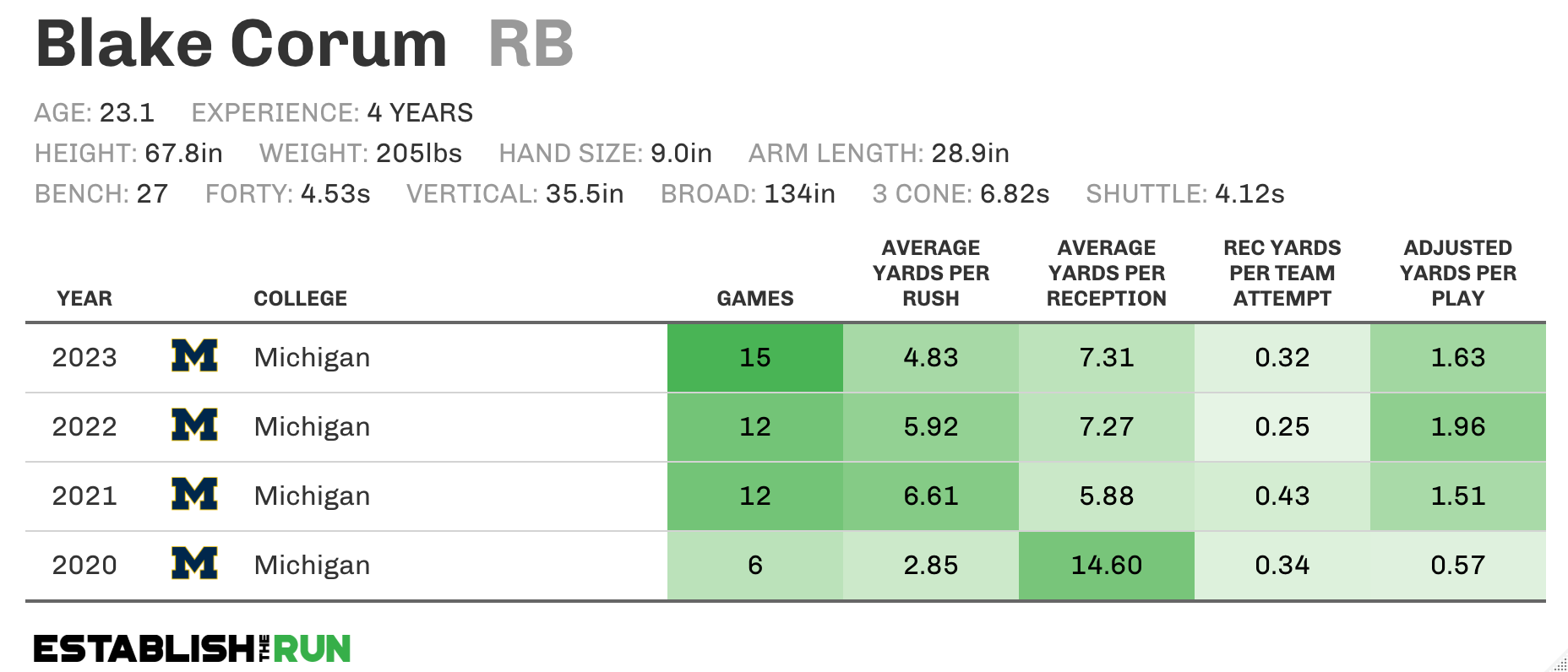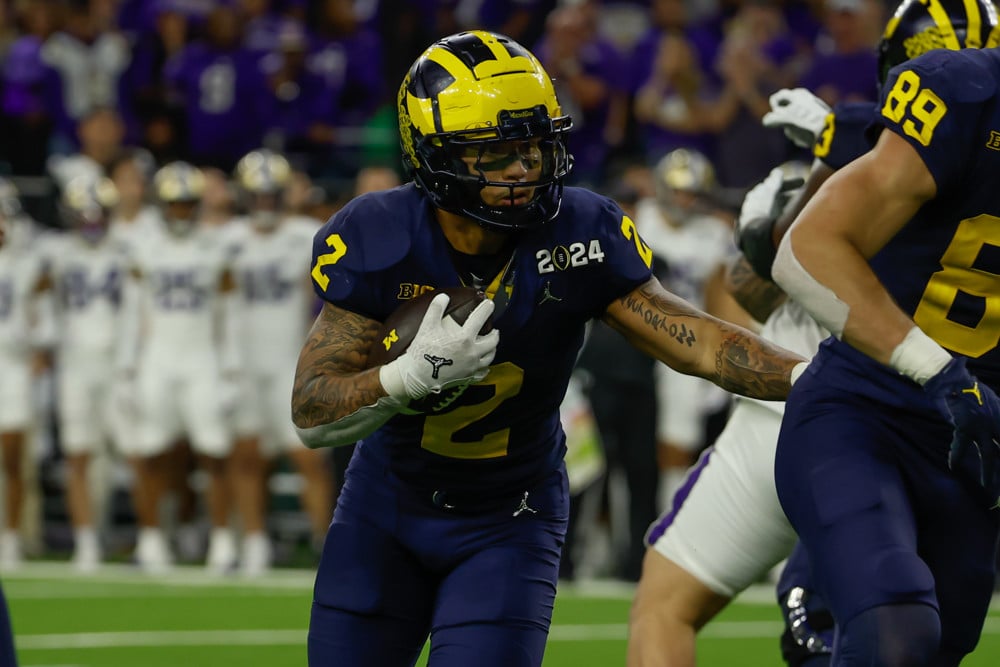Dynasty Outlook
March 27
Blake Corum is our RB2 for rookie drafts and checks in as RB21 in our overall dynasty ranks. In a class that lacks workhorses, Corum is someone who presents upside. He saw extensive work both on the ground and through the air, and was extremely productive. The real question is if he can recover fully from his 2022 injuries. That version of Corum would project as a major fantasy contributor. To account for the risk, he is just our 18th overall rookie in Superflex/TE-premium formats, but there is league-winning potential at that price.
Profile Summary
Corum plays with impressive power and quickness, though the power element may be a tough way to win in the NFL at 205 pounds and a small stature. He played in 2023 after suffering multiple knee injuries at the end of 2022, and it clearly affected his performance. The team drafting Corum will have to believe that he can regain his pre-injury form, and that is the outcome that would make him a draft-day steal.
Vitals
Age (as of 12/31/23) — 23.1
Experience — 4 years
Height — 67.75 inches
Weight — 205 pounds
Hand — 9.0 inches
Arm — 28.8 inches
Forty — 4.53 seconds
Bench — 27 reps
Vert — 35.5 inches
Cone — 6.82 seconds
Shuttle — 4.12 seconds
By the Numbers

Corum started his career during the COVID-shortened 2020 season, as part of a loaded backfield that included Hassan Haskins, Zach Charbonnet, and Chris Evans — all NFL players. Charbonnet, who ended up being a Day 2 pick, transferred out of Michigan rather than competing with Haskins and Corum. And while Corum played behind Haskins (a senior) as a sophomore, his workload went up, including leading the backfield in receptions.
2022 was when Corum got his shot as the lead back, and he was impressive in that role, averaging 5.9 yards per carry and scoring 19 times. Unfortunately, his season was cut short by an MCL sprain and meniscus tear. It was a devastating injury that clearly affected his play in 2023. Corum’s YPC dropped to 4.8 in his final season, though he remained the clear lead back for the national-champion Wolverines, scoring 27 times on the ground.
Here is the list of Power Five RBs to rush for 25 TDs or more in a season since 2000:
Najee Harris
Derrick Henry
James Conner
Melvin Gordon
Montee Ball
Toby Gerhart
Willis McGahee
Lee Suggs
Almost all of these players had some fantasy value at some point in their careers, even if they did not end up being studs. And while Corum didn’t run fast at the Combine, he dominated the agility drills. There have been 44 RBs since 2000 to run the 3-cone drill in under 6.85 seconds and be drafted. In the interest of cutting the list down, here are some of the more impressive names:
Christian McCaffrey
Ray Rice
DeAngelo Williams
Ahmad Bradshaw
Zac Stacy
Kevin Smith
Jahvid Best
Le’Veon Bell
Jerome Harrison
Stevan Ridley
Chase Edmonds
Doug Martin
Jamaal Charles
DeShaun Foster
Aaron Jones
David Johnson
Jerick McKinnon
Steve Slaton
LaDainian Tomlinson
Matt Forte
Knowshon Moreno
Rex Burkhead
These are the 22 RBs to have at least one season averaging 12 or more PPR points — half the list! And it includes some of the most productive RBs we’ve seen in this time frame.
What the Scouts are Saying
Lance Zierlein sees Corum as a three-down backup:
Compact runner with average size, outstanding contact balance, and a rare talent for finding and fitting into small crevices for short-yardage conversions and touchdowns. Corum is a bit of a one-speed runner lacking sizzle and wiggle but gets it downhill with timing and finishes runs with good forward lean. He has the hard-hat mentality to handle heavy workloads and can exploit defenses that fatigue or miss their run fits. The talent doesn’t stand out on its own, but he’s strong, competitive, and team-oriented with exceptional football character. He can catch it when needed and is above average in picking up the blitz, which could earn him status as a three-down backup with a chance to find early carries as an RB2/3.
Maurice Jones-Drew illuminated Corum’s success in short yardage:
The two-time Big Ten Conference Running Back of the Year is compact but packs a punch. Checking in at 5-foot-7 and 205 pounds, Corum is a strong runner with above-average contact balance who thrives as a short-yardage back. He led the FBS with 27 rushing touchdowns (also a school record) in 2023, and of his last 45 rushing TDs at Michigan, only 12 went for more than five yards. He wasn’t used much as a pass catcher, but he could certainly be an asset out of the backfield in the NFL.
Dane Brugler noted Corum may not play a style that fits his size:
Corum was the straw that stirred the offensive drink in Ann Arbor (FBS-best 27 rushing TDs in 2023). With the instinctive way he pairs his eyes and feet, Corum has terrific vision and an energetic lower body to read and maximize the blocking in front of him.
He wasn’t a high-volume receiving target in college and is smaller than ideal for his running style, but he makes quick, urgent decisions as a ball carrier with a low center of gravity.
Draft Projection
Corum is not rated inside of the top 50 prospects on Grinding the Mocks, which sources mock drafts around the interwebs. Mock Draft Database is a similar service that has Corum 78th overall. Neither Jeremiah nor Brugler have Corum in their first-round mocks, as there is not a RB who is expected to be selected on Day 1. Jordan Reid had two RBs in his two-round mock, but neither of them were Corum. It is most likely that Corum comes off the board in Round 3.
Comparable Players
I use Principal Component Analysis to evaluate prospects. In simplest terms, this kind of analysis looks at relevant data points to find the closest comparable players in past drafts. I prefer this to a model output — which yields only a single result — as it can display the possible range of outcomes for a prospect.
Note that the analysis itself isn’t telling us how good a player is; it is simply returning the most similar players. It is then up to us to layer in context and past results to see how good we think this player may be.

There is no other way to say it — these comps are all pretty bad. Jeremy Langford was useful as a rookie, and receiving backs Bilal Powell and Leon Washington had their moments, but the only potential starter on this list is Zamir White, and we haven’t even seen him do it yet. That’s not particularly bullish for Corum.
Of course, the comp analysis doesn’t know that Corum was injured last season, and we are projecting him as a late third-round pick on the inputs. That could mean we are underrating him with this method. But it would certainly be nice to see a few more names of note.


